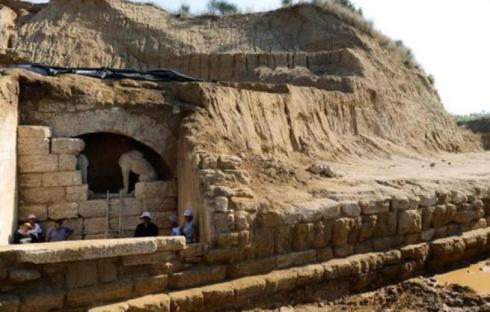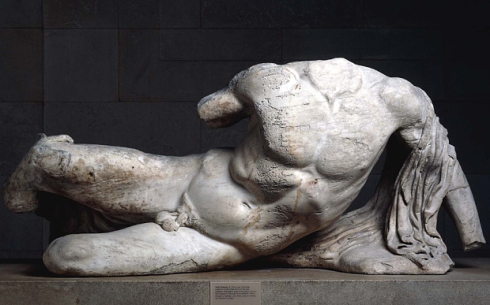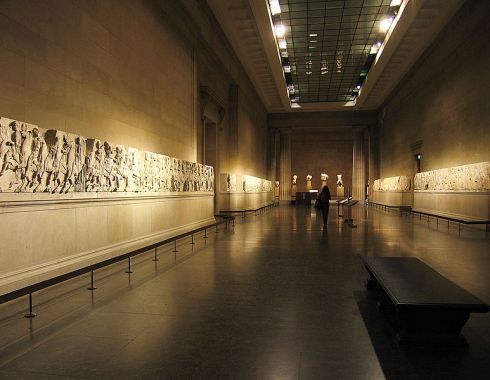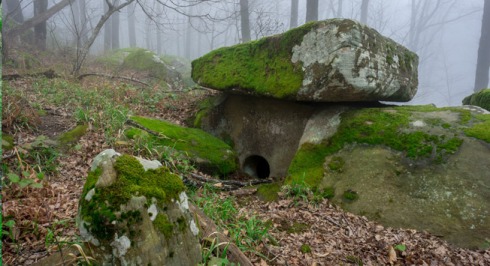You are currently browsing the category archive for the ‘Greece’ category.
“The Parthenon sculptures raises the bar for all of us… and it includes everybody all over the world… and is for all of us, all over the world.”
Playwright, author and British Museum trustee, Bonnie Greer celebrates the enduring beauty and humanity of the Parthenon Sculptures
The Parthenon was built as a temple dedicated to the goddess Athena. It was the centrepiece of an ambitious building programme on the Acropolis of Athens. The temple’s great size and lavish use of white marble was intended to show off the city’s power and wealth at the height of its empire.
Hear, hear Lara, we couldn’t have put it better, but we’d also like to ask George whether or not he’s actually seen the Marbles at the British Museum and whether or not he’s aware of the restrictions in place on the Museum when it comes to disposing of any object in its collection – whether through sale, exchange, repatriation or disposal in some other way. It can’t be done – at least not without changing the law. That’s not to say there isn’t a case to be made for the Marbles repatriation (it would certainly free up much needed gallery space for, dare we say it, more interesting exhibitions) and we’ve presented both sides of the repatriation argument on these pages before (type Elgin Marbles in the search box above for more).
I AM GREEK AND I WANT TO GO HOME
INDEPENDENT MOVEMENT FOR THE REPATRIATION OF LOOTED GREEK ANTIQUITIES
by
Ares Kalogeropoulos
Web design skoumas © iamgreek.gr 2012
The arguments for and against the restitution of the Parthenon Reliefs (the Elgin Marbles) continue unabated. Should the reliefs be returned to their place of origin in Greece or remain at the British Museum. Ares Kalogeropoulos believes passionately that they should be repatriated and writes on his website the following –
In mid-August 2009 the photographer and composer Ares Kalogeropoulos visited the British Museum in the city of London in Great Britain. Entering and passing through countless Greek rooms in the museum he saw something that inspired awe in him but also caused him great pain. Awe at the infinite beauty of the Classical Greek works, and pain that these items were all so far from the mother earth that had given birth to them. Room 18, named by the British as the Parthenon Room was what made him take out his camera and start capturing evidence of the most heinous of cultural crimes to be perpetrated in recent history: the sacrilegious defilement of the greatest monument and symbol of world culture, and the illegal retention in a foreign place of 65% of the artefacts that had decorated it. Far from the sun and sky of Athens. Broken, humiliated and above all, HALF of the monument. Pieces of the Parthenon, which has stood there in Athens for thousands of years, now fixed and hanging without any meaning at all.
This photographic archive remained in his computer until the middle of February of 2012 when it came to light because of an internal desire of the artist to express himself by making known this cultural crime to the world.
THE MOVEMENT
The first photograph was uploaded to Ares Kalogeropoulos Facebook profile in February of 2012. This photo was followed by many others that were posted daily to the profile and were then broadcast by thousands of people at an impressive and stunningly increasing rate.
There was only one message and it was clear:
“I AM GREEK AND I WANT TO GO HOME”.
It may have started as a personal expression of the artist seeking justice by projecting such an historically important cultural problem but public support through postings and actions turned it into a movement.
Ares Kalogeropoulos
More here. See also our earlier post here.
A 57 second video in support of the international campaign by S.E.A. (Greek Archaeologists Association) against IMF/EU cuts in culture – not only in Greece but elsewhere. This video was published on 18 May 2012 by S.E.A. ARCHAEOLOGISTS and is inspired by recent museum thefts in Athens and Olympia. Nineteen thousand archaeological sites are now in danger.
ACT NOW: MONUMENTS HAVE NO VOICE. THEY MUST HAVE YOURS
Writing in The Guardian yesterday, archaeologist Mike Pitts reports on the belief of some campaigning for the restitution of the Elgin Marbles to Greece that, “It [The Parthenon] inspired the Renaissance and Byron, and now the many who would like to see the bits in the British Museum – about half the surviving sculptures – given back to Greece.” But what part of Greece should the bits be given back to? Surely not (as Mike points out) to the Parthenon itself as that site remains a place of shambolic restoration where little or nothing ever seems to happen and where, in these cash-strapped times, that situation is unlikely to change (not to mention that the Parthenon is on a hilltop in the middle of one of Europe’s most polluted cities). So, if not to the Parthenon itself, then where? To the new Acropolis Museum in Athens? If the Elgin Marbles were moved there from the British Museum they would simply be moving from one museum to another – actually to a museum where fewer people are ever likely to see them.
For those who argue that the Elgin Marbles are somehow unique shows a bias towards Western culture and an ignorance of the British Museum’s collection (and purpose). The Chinese have an equally valid case for having the Dunhuang paintings and manuscripts returned from the BM and the British Library – ditto Egyptian and Syrian objects to those countries. In fact 99% of the objects in the BM are unique, and a case could be made for the restitution of any and all of them. Result – a very dull if not half-empty British Museum.
There are several points in the Elgin Marbles restitution argument (and the restitution of museum objects in general) that might be worth remembering. The first (unless the law has changed) is that the British Museum is unable to dispose, by any means, of an object in its collection. That, and national interests aside, would it actually benefit humanity to return the Elgin Marbles to their place of origin? The Marbles are a good example where it would not, as they would inevitably end up in the Acropolis Museum, not on the Parthenon, where they would be seen by fewer people than at present. Ironically, during the Olympics this year, more people are likely to see the Marbles at the British Museum than they would if they were on display in Athens. It’s also worth asking whether an object would be better conserved and displayed in its new location than its present location – if it isn’t then the case for restitution becomes null and void.
Other points perhaps worth remembering are that, with advances in digital technology and the very high standard of reproductions now achievable, is it really necessary to have the ‘original’ on display in its place of origin (or, in some cases, even on display)? Surely the guiding principle should be how well an object can be preserved for posterity while allowing the maximum number of people to appreciate it (or a replica of it). We can see that trend already at Lascaux and at the Takamatsuzuka Kofun in Japan. There is, perhaps, at least one exception to that rule – ie when an object such as the Haisla totem pole which Mike Pitts mentions in his article, or any other object still forming part of a living tradition, has been taken out of that tradition and out of the context for which it was intended.
Guardian article here. See also Greg Jenner’s article in today’s Huffington Post.




